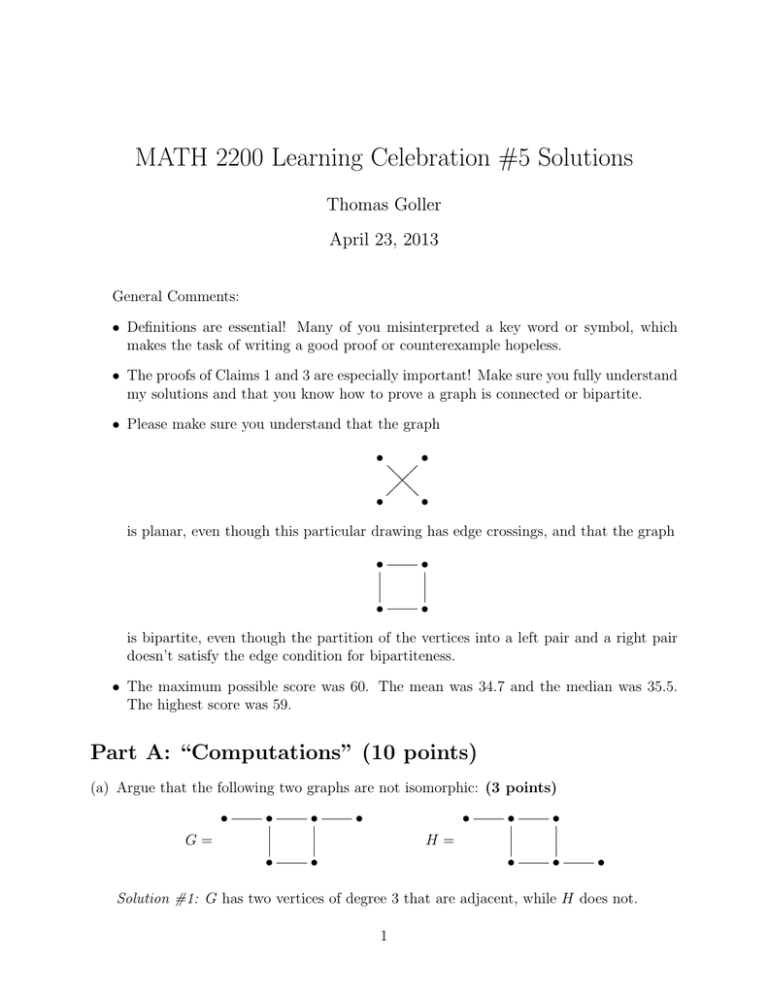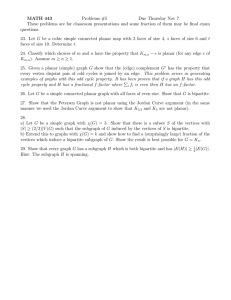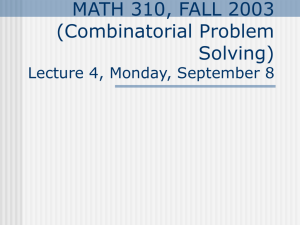MATH 2200 Learning Celebration #5 Solutions Thomas Goller April 23, 2013
advertisement

MATH 2200 Learning Celebration #5 Solutions
Thomas Goller
April 23, 2013
General Comments:
• Definitions are essential! Many of you misinterpreted a key word or symbol, which
makes the task of writing a good proof or counterexample hopeless.
• The proofs of Claims 1 and 3 are especially important! Make sure you fully understand
my solutions and that you know how to prove a graph is connected or bipartite.
• Please make sure you understand that the graph
•
•
•
•
is planar, even though this particular drawing has edge crossings, and that the graph
•
•
•
•
is bipartite, even though the partition of the vertices into a left pair and a right pair
doesn’t satisfy the edge condition for bipartiteness.
• The maximum possible score was 60. The mean was 34.7 and the median was 35.5.
The highest score was 59.
Part A: “Computations” (10 points)
(a) Argue that the following two graphs are not isomorphic: (3 points)
G=
•
•
•
•
•
•
H=
•
•
•
•
•
•
Solution #1: G has two vertices of degree 3 that are adjacent, while H does not.
1
Solution #2: G has two vertices of degree 2 that are adjacent, while H does not.
Solution #3: H has a vertex of degree 2 that is adjacent to two vertices of degree 3,
while G does not.
Solution #4: In G, the shortest walk between the two vertices of degree 3 requires 1
edge, while in H the shortest walk between the vertices of degree 3 requires 2 edges.
Solution #5: G has a vertex that is adjacent to vertices of degrees 1, 2, and 3, while H
has no such vertex.
(b) Let G be the graph obtained from the complete bipartite graph K3,3 by removing one
edge. We proved in class that K3,3 is not planar, but show that G is planar by drawing
it in the plane without edge crossings. (5 points)
Solution:
•
G= •
•
•
•
• =
•
•
•
•
•
•
(c) Use your drawing in (b) to show that G satisfies Euler’s formula. (2 points)
Solution: The planar drawing of G in (b) has four regions. This agrees with the Euler’s
formula computation
r = |E| − |V | + 2 = 8 − 6 + 2 = 4.
2
Part B: Claims (50 points)
Claim 1. Let n ∈ Z≥1 . Let G = (V, E, φ) be the graph defined by V = {v0 , v1 , . . . , vn },
E = {e1 , . . . , en }, and φ(ei ) = {v0 , vi } for each 1 ≤ i ≤ n. Then G is connected.
Proof. Let vi , vj ∈ V with vi $= vj . If vi = v0 , then (v0 , ej , vj ) is a walk in G from vi to
vj . If vi $= v0 and vj =
$ v0 , then (vi , ei , v0 , ej , vj ) is a walk in G from vi to vj . Thus G is
connected.
Comments:
• The first step in attacking a claim like this is to draw the graph described by the
notation. Choose small values of n and draw the graphs! It should be clear from your
drawing how to walk between any two vertices in the graph.
• Use the notation established in the claim to simplify your proof! When you pick
arbitrary vertices, call them vi and vj . Then you automatically know which edges are
adjacent to vi and vj , namely ei and ej .
Claim 2. Let H1 and H2 be planar subgraphs of a graph G. Then H1 ∪ H2 is planar.
This claim is false! Counterexample: Let
•
G = K3,3 = •
•
•
•,
•
•
H1 = •
•
•
•,
•
•
H2 =
•
Then H1 is planar by (b) of Part A, and H2 is clearly planar, but H1 ∪ H2 = G = K3,3 is
not planar.
Claim 3. Let n ∈ Z≥1 . Let G be a cycle of length 2n. Then G is bipartite.
Proof. Since G = (V, E, φ) is a cycle of length 2n, we can write V = {v1 , . . . , v2n } and
E = {e1 , . . . , e2n }, such that φ(e1 ) = {vn , v1 } and φ(ei ) = {vi−1 , vi } for all 2 ≤ i ≤ 2n. Set
V1 = {v1 , v3 , . . . , v2n−1 } and V2 = {v2 , v4 , . . . , v2n }. Then V = V1 & V2 and every edge has
one endpoint in V1 and the other endpoint in V2 , so G is bipartite.
Comments:
• A good first step in writing the proof of this claim is to pick some names for the vertices
and edges. This allows you to precisely define the sets V1 and V2 and makes the edge
condition for bipartiteness obvious.
3
Claim 4. Let H1 and H2 be connected subgraphs of a graph G. Then H1 ∩ H2 is connected.
This claim is false! Counterexample:
G= •
•,
H1 = •
Then H1 and H2 are connected, but H1 ∩ H2 = •
•,
H2 = •
•
• is not connected.
Claim 5. Let H be a subgraph of a planar graph G. Then H is planar.
Proof. Since G is planar, it can be drawn in the plane without edge crossings. By removing
the vertices and edges of G that are not contained in H from this drawing, we obtain a
drawing of H without edge crossings. Thus H is planar.
Comments:
• Note that G being planar ensures only that G can be drawn in the plane without edge
crossings, not that every drawing of G has no edge crossings.
• Your task is to use the fact that G can be drawn without edge crossings to prove that
H can be drawn without edge crossings. So use your drawing of G to describe how to
get an appropriate drawing of H!
4






